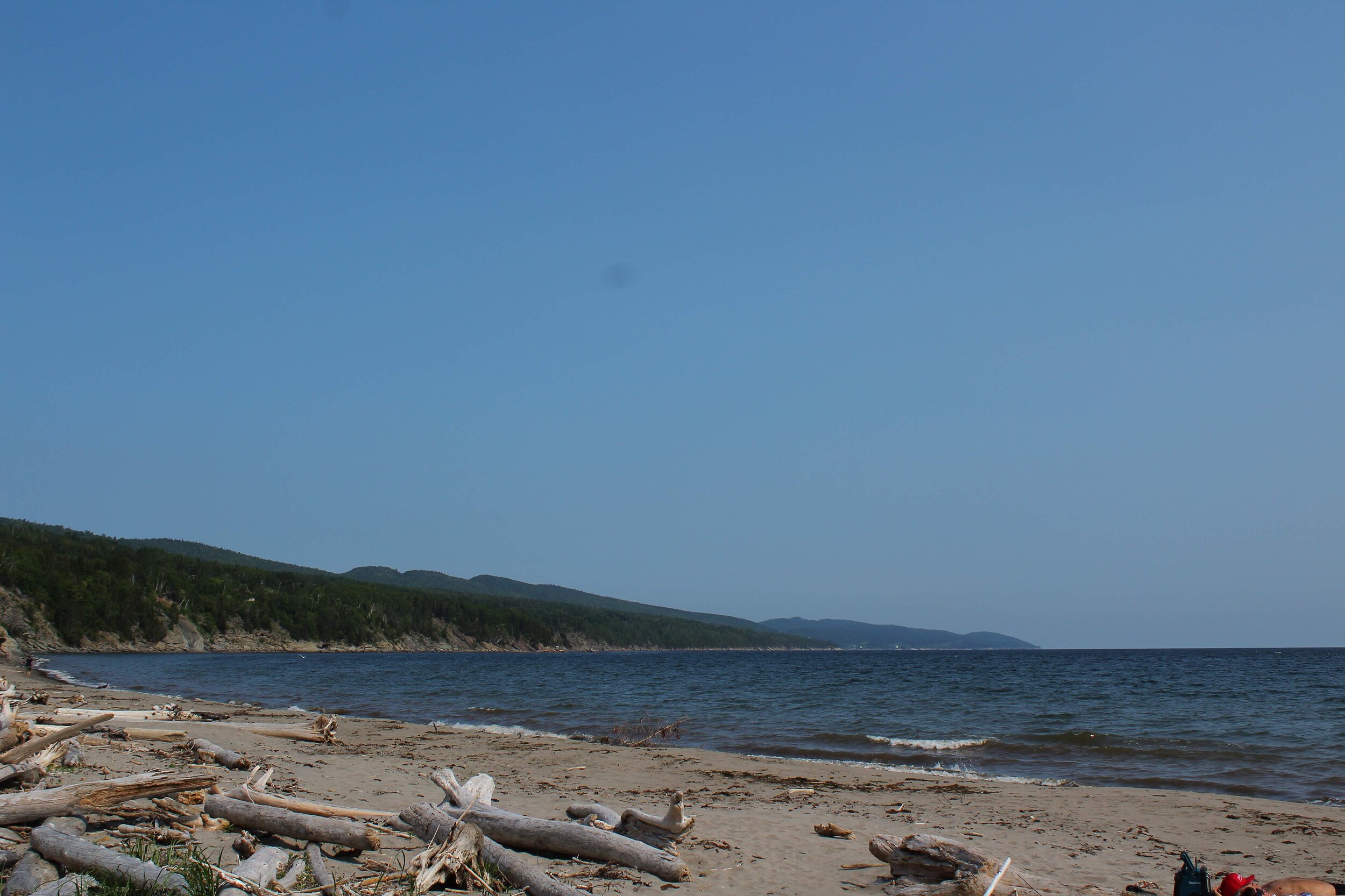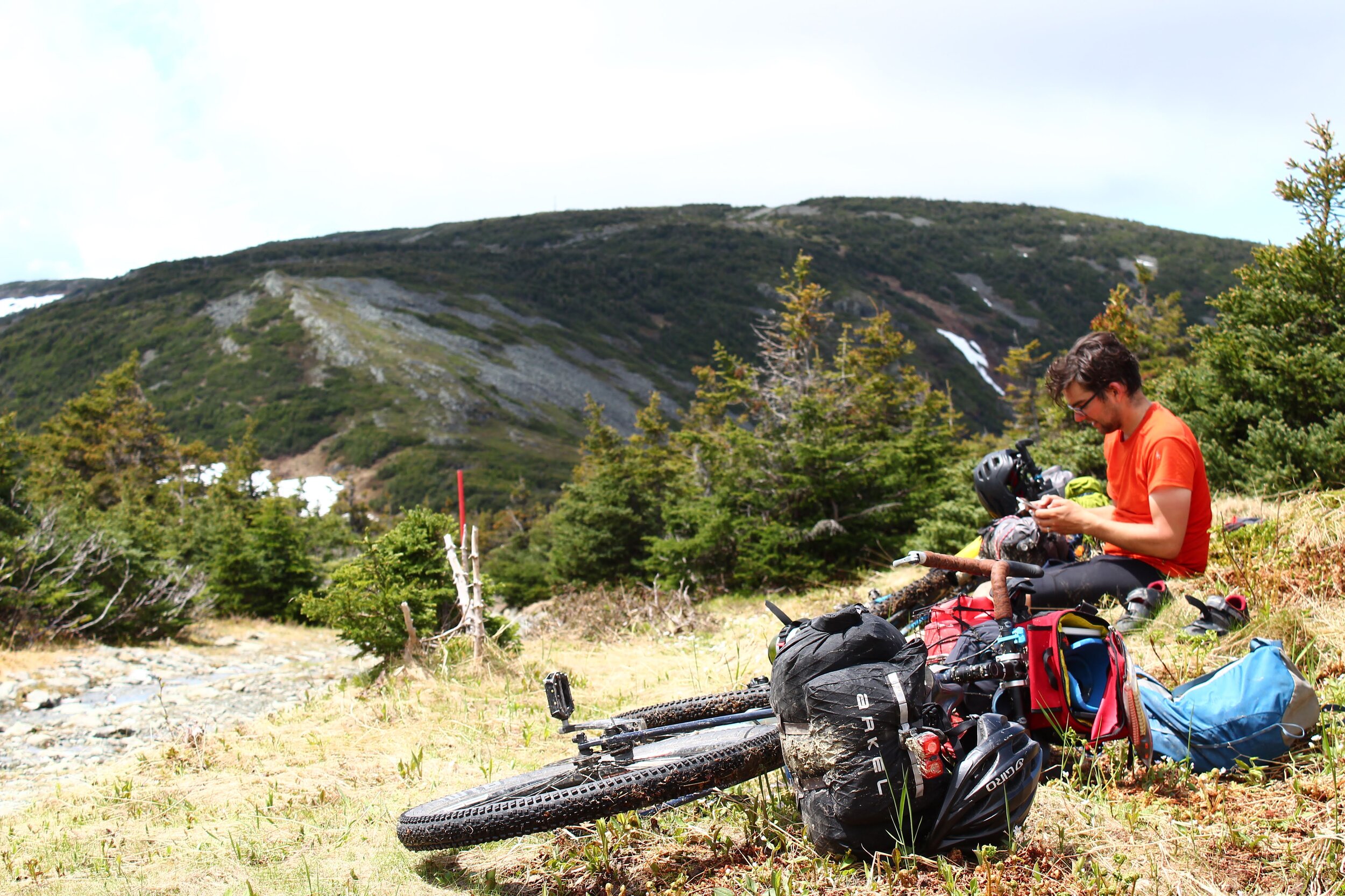La Transgaspésie : a Gaspé Peninsula traverse
Route and photos by Jérémie Bourdages-Duclot
La Transgaspésie is an epic traverse of the beautiful Gaspé peninsula, situated in Eastern Québec. Starting in the Matapedia Valley, the route climbs sinuous backcountry roads up to the Chic-Chocs mountain range, where snow can stick around until the early weeks of summer. Doubletracks, gravel roads and a few miles on pavement brings the rider to amazing landscapes: through the subalpine panoramas of Mt Logan and the Vallières areas, remote valleys and the boreal forest, pristine salmon rivers and, at the very end, breath-taking views of the Cap-Bon-Ami cliffs overlooking the sea.
The inspiration behind the route
I have a strong affection for this region. My family on my mother’s side is gaspesian, and I used to go there on vacation every summer, hanging with local kids and running on the beach. Later on, I went to study Adventure tourism in the town of Gaspé, and I worked as a tree planter for four seasons, deep in the woods of this beautiful region. When I discovered bikepacking, I knew instantly that the Gaspé peninsula would be an incredible playground for it. There are dirt roads everywhere. Doubletracks used by ATVs and hunters, forest roads, gravel roads, some great singletrack. The scenery is truly incredible, with a mix of alpine mountains (the Chic-Chocs and the McGerrigle ranges have tons of bare mountain tops, above 1000m of altitude), crystalline rivers and ocean views. Quebecers already know this is a top-class outdoors area, for backcountry skiing, rafting and canoeing, sea kayaking, and hiking. The Tour de la Gaspésie is also a bike touring classic trip, on the paved 132 highway. But this place was naturally made for bikepacking.
With the help of local riders, Luc, Jérémie (another friend of ours, who couldn’t make the trip) and myself worked on the route during spring 2019. We hit the trail at the end of June and we spent 7 days of pure bikepacking delight!
By the numbers
Distance: 447 kms
Total ascent: 6997 m
Amount of route Unpaved: 80%
Logistics and details
Where to start
I suggest you start at Amqui, in the Matapedia Valley (or la Vallée, as we call it!). It doesn’t take long before you ditch pavement, and for a while! Leave your car at local shop parking where people won’t mind. You can also sleep at the camping of Amqui the night before your trip.
The finish
The end of the Transgaspésie is at Cap-Gaspé, also known as “Land’s End”, where the peninsula finishes in a wide oceanic panorama in the St-Lawrence Gulf. The views are however just as great, if not better, at Cap-Bon-Ami, a federal park camping nearby. Once there, cycle some pavement back to the town of Gaspé or to your car, if you left one in advance. You should be able to find a bus departure from Gaspé every week with Orléans Express (check their COVID modalities, though, it can change!).
Camping
All the good camping options are indicated on the RWGPS link. Many of them are in Wildlife Reserve areas or in National Parks, but a few good spots can be found on public lands. Just make sure you are not on private property or Réserve faunique land.
Wildlife
The Gaspé region is visited by hunters from all of Québec during the fall, with good reason. It wouldn’t be a surprise if you cross a moose, a coyote or a bear. Make sure to bring bear spray and to hang your food in a proper way each time you camp in the wild. During our trip, a moose notably licked my partner’s tent in the middle of the night!
The best bike
This is a beautiful dirt bikepacking route. A hardtail with front suspension or a rigid MTB are very good options for enjoying the ride, since a few sections are rough and some descents would benefit from suspensions or plus tires. However, I did the route on a dirt drop bar and had a great time. Just know that if you try it with a gravel bike and tires under 2.0 inches, you might walk more than you would like to. Try to be minimalist and expect to push your bike, no matter which type : some sections are short but very tough and steep.
Number of days to complete
As always, your physical condition and your schedule determine the pace. Unless you’re an athlete, 5 to 7 days is, I think, the minimum time needed to tackle the climbing and rougher stretches.
Best season to ride the route
Since the snow can stick around a long time in higher altitudes and the trails can stay very muddy late in spring, I recommend riding it in July or August. You’ll run less risk of encountering snow. Mosquito season is in June, normally (bring a net, you’ll need it). September is a bit late, since the hunting season begins and almost all the route goes through risky areas. Note that there may be some water crossings as well, so water levels will be higher earlier in the season.
Additional info and modifications
At km 264, the mountain range of the Vallières de St-Réal is actually a detour, but I think it’s absolutely worth it. It gets the rider closer to wilderness, offers great views on valleys and subalpine scenery and the doubletracks are very enjoyable. Lacking time? You can simply zip through the main gravel road linking the 299 to Murdochville.
Other options exist for doing a Gaspé traverse. I believe this route is a beautiful, logical and diverse one, but feel free to choose alternatives that work for you! One option is to ride closer to the north of the peninsula, instead of following the St-Jean river. That possibility was explored by other passionate cyclists, working on an epic trip going through the whole province (the Québec Bikepacking Traverse), and their route also goes through a kind of “transgaspésie”. Their option finishes in the town of Percé, further south on the Peninsula coast. If you would like to explore alternatives, look up this route segment (https://ridewithgps.com/routes/31671486) as well as the website Québec Bikepacking Traverse!
Special thanks to Guy Bouchard and Bobby Cotton, local riders involved in Gaspé bikepacking development who helped us in the route mapping process.
If travelling during Covid-19, please research all local and/or regional travel restrictions and be aware, respectful and conscientious of the communities you are travelling through.





















Level of difficulty
This route should be attributed a 6/10 difficulty grade. The steep and long stretches of climbing, some rough doubletrack descents, the singletrack of Béchervaise, the infamous Sentier des Lacs at Forillon National Park, and, of course, the necessity to cover a good milage to reach pit stops make it less accessible to beginners. Nevertheless, if you are well prepared, are in decent physical condition and are used to camping in the wild, you will love it. There are some technical stretches, but unexperienced mountain bikers can definitely make it through.
Route GPS
Click here for the Ride With GPS Route.
Note: A website dedicated to the route can also be found here.
About the contributor
Jérémie Bourdages-Duclot is a physical education teacher living in Sherbrooke who loves being outdoors at large, especially on his bike doing gravel/touring/bikepacking. After riding both in Québec and internationally, he discovered that his own backyard is a perfect destination. The Transgaspésie was a perfect opportunity to discover the region he fell in love with, so long ago.
Note: Please use the route and all of the routes on messkitmag.com at your own risk. Before you head out do your own due-diligence, be responsible for your own trip safety and always check current weather, road conditions, and land/road closures.While riding, obey all land restrictions and rules, carry proper cycling gear, leave no trace and respect the land used. If travelling during Covid-19, please research all local and/or regional travel restrictions and be aware, respectful and conscientious of the communities you are travelling through. The information found in each route is simply a planning resource and the accuracy of the route is not guaranteed, meaning messkitmag.com and its contributors are in no way liable for personal injury, damage to personal property, or any other such situation that might happen to individual riders cycling or following this or any of our routes.






















